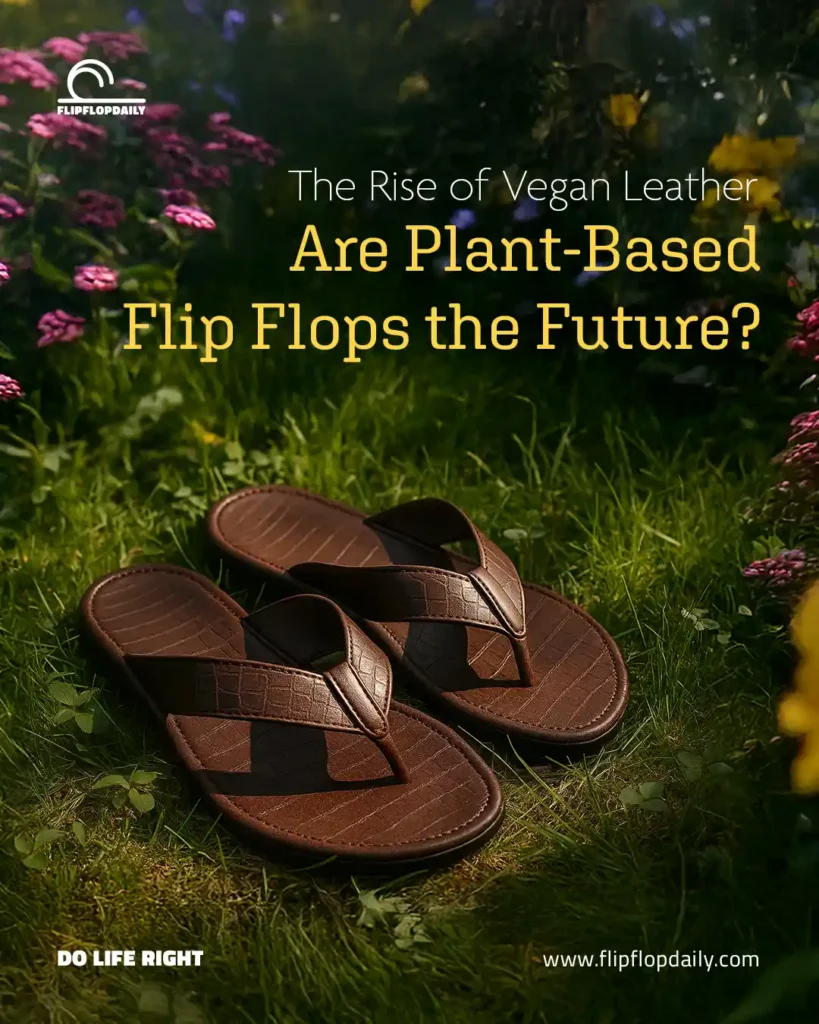Flip flops—including Plant-Based Flip Flops—are more than just shoes. They’re freedom, sunshine, and that easy-going energy that tells you summer has arrived. People search for “flip flops” hundreds of thousands of times each month, which proves one thing: we’re obsessed. (Google Trends)
But here’s the catch. While we’re busy living the good life in our favorite sandals, more and more of us are starting to ask—what kind of mark are these flip flops really leaving? Not the cute tan line kind, but the environmental one. That question is shaking up the fashion world, and believe it or not, the humble flip flop is now part of a much bigger sustainability revolution.
Vegan Leather, Decoded
“Vegan leather” has become a buzzword. You’ll see it stamped on handbags, sneakers, jackets, and yes, flip flops. At its simplest, it means leather-like materials made without animal skins. No cows, no cruelty. (PETA: What Is Vegan Leather?)
The idea first gained traction as an ethical choice. But it also sidesteps the huge environmental mess tied to traditional leather: cattle ranching that drives deforestation, massive water use, and chemical-heavy tanning. It’s estimated one kilo of leather can take 17,000 liters of water just to raise the cattle alone. That’s before you even get into the toxic brew of chromium and formaldehyde used to tan hides.
Sounds grim, right? That’s where vegan leather came in—only the first versions weren’t exactly planet-friendly either.
The Problem with Old-School Pleather
Early vegan leather was basically plastic in disguise. Think PU (polyurethane) or PVC (polyvinyl chloride).
- PU leather is softer and more flexible, which made it a go-to for shoes and bags. But it’s fossil-fuel based and not biodegradable, meaning it sits in landfills for hundreds of years.
- PVC leather is worse. It’s rigid, less breathable, and produces toxic byproducts during manufacturing and disposal. Greenpeace even called PVC the “single most environmentally damaging plastic.”
So yes, it ditched animal cruelty—but swapped it for pollution and microplastics. Not exactly the sustainable solution we were hoping for.
Enter: Plant-Based Innovation
Fast forward to today and things are looking way more exciting. Scientists and designers are getting creative with natural and recycled resources. Flip flops (and fashion in general) are now being made from cactus, pineapple leaves, apple waste, and even mushrooms. Pair that with recycled tires or water bottles, and you’ve got a whole new generation of eco-friendly footwear.
Here are some of the coolest plant-based leathers leading the way:
- Desserto® (Cactus Leather): Grown from prickly pear cactus in Mexico. Needs no irrigation, absorbs carbon, and still feels soft, breathable, and durable.
- Piñatex® (Pineapple Leather): Made from pineapple leaves—an agricultural byproduct in the Philippines. Strong, light, and gives farmers an extra income stream.
- AppleSkin™: Upcycles leftover pulp and peels from juice-making in Italy into sleek, water-resistant material.
- Mylo™ Mushroom Leather: Created from mushroom root systems (mycelium) in vertical farms. Incredibly sustainable and already spotted in high-fashion collabs.
Most of these are still bio-composites (meaning they mix natural fibers with binders like PU to boost durability), but they’re a massive improvement over plastics. And with more research, they’re only going to get greener.
The Showdown: Animal vs. Plastic vs. Plant-Based
Let’s break it down:
- Animal leather: Super durable, develops a patina, but it’s water-guzzling, chemical-heavy, and tied to deforestation.
- Plastic vegan leather (PU/PVC): Cruelty-free, waterproof, but still a fossil fuel product that sheds microplastics.
- Plant-based vegan leather: Cruelty-free, lower impact, uses waste streams or hardy crops like cactus. Not always 100% biodegradable yet, but heading in the right direction.
Performance-wise, plant-based leathers are holding their own. They’re durable, water-resistant, and stylish—making them real contenders for everyday sandals.
Brands Already Doing It
Eco-friendly flip flops aren’t some distant dream. They’re on the market right now, thanks to both niche innovators and mainstream brands:
- Bohema – Polish artisans making sandals out of cactus, pineapple, and even grape leather.
- NAE Vegan Shoes – Portuguese brand using Piñatex®, cork, and recycled tires.
- Reef – Classic surf brand reworking bestsellers with sugarcane foam and recycled PET straps.
- Ecoalf – Spanish label crafting minimalist flip flops from recycled tires and algae foam.
- Oka-B – Made in the U.S. with soy-based resin and a recycling program.
The fact that brands ranging from boutique to global are investing here shows just how fast the movement is growing.
How to Shop Smarter
Want to actually buy a sustainable pair? Here are three quick checks:
- Don’t stop at “vegan.” If it just says “synthetic leather,” it’s likely plastic. Look for names like Piñatex® or Desserto®.
- Check the glue. Some shoes use animal-based adhesives even if the upper is vegan. Look for “100% vegan” or cruelty-free certifications.
- Think long-term. The longer your sandals last, the fewer pairs end up in landfills. Wipe them clean, don’t cook them in the sun, and store them properly.
So… Are Plant-Based Flip Flops the Future?
All signs point to yes. These aren’t just gimmicks anymore. Materials like Piñatex® and Desserto® are already proving they can handle real-world wear without sacrificing comfort or style.
Even better, the market for vegan leather is exploding—it’s projected to surpass $25 billion by 2032. That growth is powered by consumer demand. Every time you choose cactus leather over cowhide, or sugarcane foam over plastic, you’re pushing the industry forward.
Flip flops have always been about freedom and fun. Now they can also be about freedom for animals and a lighter footprint for the planet. And honestly? That makes sliding into them feel even better.
It’s time to Do Life Right!
Check out the best flip flop reviews, flip flop advice and flip flop philosophy on how to live a flip flop life!

